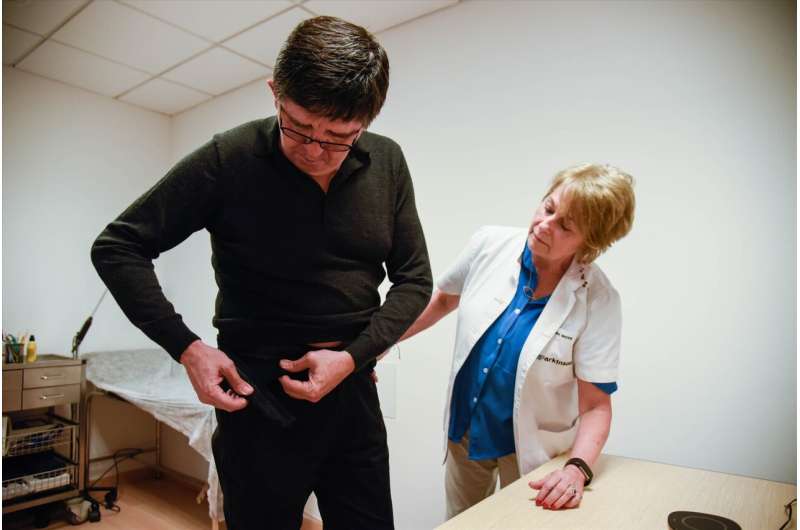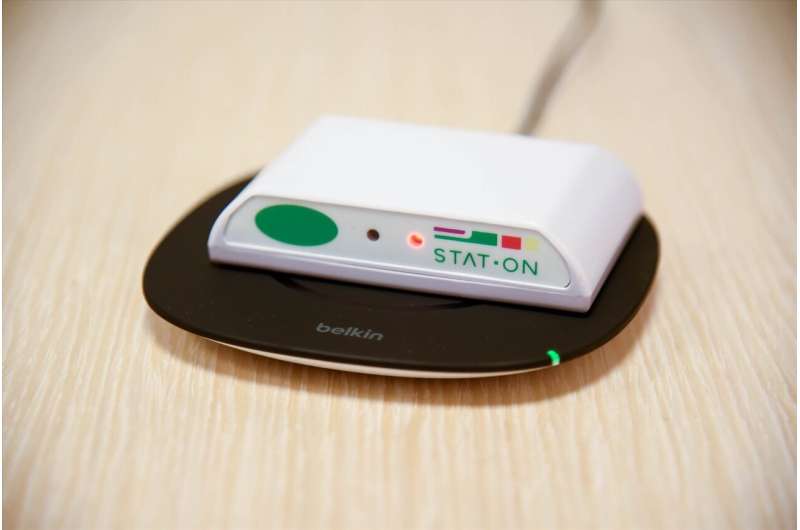Device continuously monitors the symptoms of patients with Parkinson's

Until now, the lack of precise, continuous data on the clinical status of individuals affected by Parkinson's disease throughout the day was one of the main difficulties faced by neurologists in charge of adapting treatment. Now, this obstacle has been overcome with a new device called STAT-ON. It is a small sensor held in place with a specially designed belt that constantly monitors patients' motor status in everyday settings.
Current treatments for Parkinson's are symptomatic, designed to compensate for the absence of certain neurotransmitters such as dopamine. After around two years of effective control using levodopa (the precursor to dopamine), fluctuations of around 50 percent appear in patients.
As a result, the motor symptoms of advanced Parkinson's patients fluctuate several times a day in relation to levodopa levels. These are known as "on periods" and "off periods," and they are the result of the availability or absence of dopamine in the brain.
"On" periods typically begin soon after the patient has ingested medication, and they generally correlate with periods when patients feel good and enjoy practical and normal control of movement. "Off" periods are generally when motor symptoms appear, severely limiting many patients' mobility and independence.
The treatment of advanced Parkinson's focuses on controlling these fluctuations, but until now, neurologists have found it difficult to correctly analyse them. It is common practice to ask patients to keep a diary, writing down their clinical status each hour. This requires a significant time investment by the patient and caregivers, and the resulting data can be unreliable, as it is often difficult for patients to self-assess. In addition, motor problems often make it hard for patients to write.
STAT-ON continuously monitors the on/off fluctuations experienced by patients under levodopa treatment over several years. It also monitors other motor symptoms experienced by the patient (bradykinesia, dyskinesia and freezing) in order to allow for much more precise treatment and significantly improving patients' quality of life. These on/off fluctuations present significant challenges to patients' clinical stability through dosage adjustments. In addition, STAT-ON can monitor gait parameters, falls and other characteristics of movement that allow for improved management of the disease.
"The measurements and data provided by this device will help doctors make informed decisions and better manage the disease. It's important to note that this device doesn't provide a diagnosis, although the information it collects is extremely helpful to health professionals, allowing them to precisely determine a patient's status," notes Dr. Àngels Bayés, from the Parkinson's Unit at Centro Médico Teknon—Quirónsalud. Dr. Bayés participated in the development of this new device.

Since each individual moves differently, STAT-ON is designed to adapt to each patient. To do so, it uses the information it initially receives from the patient and "learns" from their movement. Then, through artificial intelligence, it personalizes the algorithms it uses to register their motor symptoms. Once this step is completed, STAT-ON works autonomously and is very easy to use. While carried by the patient, it does not require any sort of activation or connection.
"Since the device is non-invasive, patients can use it in their everyday lives, carrying the sensor on a comfortable, discreet belt while it registers their motor status. Then, it generates a report on the patient's motor status throughout the day," says Dr. Joan Cabestany, telecommunications engineer, UPC researcher and expert in artificial and electronic intelligence applied to dependency and active aging.
Growing incidence of Parkinson's
The incidence of Parkinson's disease has grown in recent years, largely as a result of longer life expectancies in the general population. Over 7 million individuals worldwide have been diagnosed with this neurodegenerative disease; 1.5 million live in Europe and 150,000 in Spain.
The disease causes progressively serious motor problems, and may result in freezing as well as hidden non-motor symptoms including pain, apathy, confusion, difficulty speaking, disturbed sleep and depression. According to data from the Spanish Society of Neurology, each year 10,000 new cases of Parkinson's are diagnosed, and it is the second most frequent neurodegenerative pathology, after Alzheimer's.



















